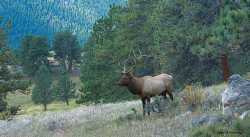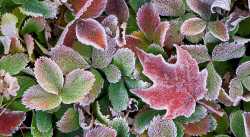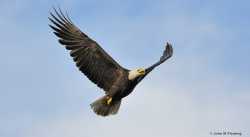
Elk-Bull-Rocky-Mountain-National-Park
As with other pictures , fine art nature photography is meant to communicate . Nature photos that are good will do a good job at communicating and will portray subjects the way you want to . The composition is crucial for great results. Here’s a look at some of the most important basic fine art nature photography techniques , and how to use them . Remember – an amateur can take a great photo once in a while , but practice is needed to do this purposefully!
Composition in photography refers to how the visual elements are arranged . This gets done by photographers using a variety of elements like tone, line, lighting, color, and more . Although when taking a photo it’s tough to remember them all , you can simplify this process. Just look through the camera viewfinder and ask yourself a few questions . What’s the photo’s message , and how can you communicate it best ? If you figure out the answers, most of the other factors will fall into place .
Fine art nature photography becomes more successful if you have a message that is clear. This doesn’t mean all the photos you take an allegory or even a statement politically. Usually the messages are quite simple , and tough to put into words. But a message is found in good photos. You simply must think .
Remember to keep things simple as you compose , especially when you’re just starting out with fine art nature photography . Don’t use a photo to showcase many subjects – just one will do . Some professionals actually look at scenes in terms of what they can remove and yet keeping the composition good. Fine tune things through your viewfinder until as many distractions as possible are removed.
Make sure you remember to be patient . You won’t get good composition in an instant, while it may look that way with experienced photographers. Up to ten minutes can be taken to compose some of these photos . While some photography does require quick pointing and shooting , you need to slow down as much as possible .
Don’t ignore any part of the scene . Ensure the frame is filled with areas that are on message and interesting . Get closer or zoom in to keep it from becoming hard to see . Take some verticals too – most people take primarily horizontal photos . But trees and mountains are important, too ! Lines are everywhere – recognize them to improve photos, instead of letting them interfere .
While good fine art nature photography may require practice , it’s incredible how a bit of care can take photos and improve them. Check it out yourself !
ÂÂ

Hoarfrost-on-Strawberry-&-Maple-leaves
ÂÂ
ÂÂ
The Fine Art Nature Photography of well known nature and wildlife photographer John M Fleming will be featured in the upcoming exhibit at the Saugatuck Center for the Arts entitled: Micro/Macro a Fresh View of Saugatuck & Douglas. Flemings Macro images span the seasonal range from ice formations along the Lakeshore and amazing moments near the Kalamazoo River. John’s photographic images depict a visual journey exploring the diversity and magic of nature. Colors dance and patterns swirl into focus on the canvas as we experience the sensitive and technical expertise of this seasoned professional. “Visually discover the pebbles, snowflakes, ice shards, and leaves. These artful views capture the mighty – and quiet – beauty of our shoreline region†remarks Kristin Armstrong, Executive Director of the Saugatuck Center for the Arts.
ÂÂ
Soar over the shoreline and the dunes while viewing the splendid images of Chicago photographer Bill Werme.
ÂÂ
It is no wonder that Fleming’s work has been featured in several publications over the years including Birder’s World, Michigan Resources, Michigan Audubon and Wyoming Wildlife. His fine art nature photography prints are on display at the Kalamazoo Center for the Healing Arts, Saugatuck Artists Collective and Framing for Friends all located in Southwestern Michigan. An electronic portfolio can be viewed on his website: johnmfleming.com.
ÂÂ
Fleming’s photographic journey began as a young boy on his grandparent’s farm while exploring through the lens the curious antics of the farm animals. Continuing alongside his father Fleming photographically explored sections of the United States and Canada including national parks, state parks and sanctuaries recording visual experiences on the interplay of light on the natural world. Not to mention collecting many great stories along the way. An environmentalist and naturalist at heart Fleming reads and studies his subjects while calling on one of his greatest virtues: patience. Patience has enabled him to sit uncomfortably for hours while waiting for the pose, for the dance, for the light, for the wind to quiet for the perfect image. One of his most popular images is that of a mother loon just emerging from under the water with food for her two young. Just as she shakes the water droplets from her wings the two, flanking either side, look at each other. At that moment the sunlight danced upon the water and streaked a light blue, connecting the three in a family portrait.
In the winter months when Fleming wanders the countryside where he resides in Douglas, Michigan along the shoreline and through the woods, one wonders if patience is still a virtue. Winter means wind, cold, ice and snow. And it is results of these photo experiences that we are privileged to see some of the smallest wonders of creation. Snowflakes, ice shards and many other details at the waters edge. Seventeen of John M Flemings macro images can be viewed in the Bertha Reid Exhibition Hall, January 9, 2010 through March 1, 2010 Monday through Friday, 9-5 est. Opening reception January 16 from 6-8 pm. All images are available for purchase during the event with proceeds funding future exhibits at the SCA. For more information please visit: www.johnmfleming.com and www.SC4A.org
ÂÂ
- Bald Eagle in Flight
Nothing is more fun than rearranging or decorating your home to give that fresh feel of newness to a house you’ve had for some time . Although it can cost a lot for artwork , there is something to be said for fine art nature photography to give your home a personal touch .
Whether you are going for an everyday country comfort feel or something elegant and high class , you can use photography as fine art to get exactly what you want from every room of your home .
Play With Color
Fine art photography that features imagery of nature can vary from bright bursts of color to muted shades of gray, black, white, and brown . This gives great versatility if you enjoy experimenting with different colors for interesting effects.
If you’re decorating a room with just a couple primary colors , an accent color will probably be needed to complete the entire picture . Fine art nature photography can add those dashes of accent color , or can bring out accents that are include in the room .
You can go with fine art photos of nature that go along with the primary colors you’re using , or for a room that has dull colors, you can go with photos that have bright colors . With great placement and the perfect colors, these photos can complete your home design.
Incorporate Themes
It is extremely fun to incorporate themes into some rooms of the home , particularly in the play room or even a child’s bedroom. Art studios and other rooms used for recreation and hobbies can work well with exciting themes .
Fine art nature photography allows you to easily pull together a theme. Actually, some photos can give you a theme for the room , letting you take the patterns and colors in the image pulling everything in the room together.
For example , a photo of a fawn in grass can be the base for a child’s bedroom that is cute and unique. It can make you think of Disney characters like Bambi that kids really love, even yet today.
You can use water as a theme that lends elegance to a room. Photos that are fine art that feature running streams, lakes, rivers, or oceans can really give you a great effect when you use fish tanks and tabletop water fountains in the room .
Come Up with a Focal Point
Picking out the right fine art photo and going with a framed print that is large can create a point of focus that catches everyone’s eye . This is great if you want to bring attention to one area of the room , or if there are other areas of the room that you need to distract attention away from .
When your focal point is a fine art photo , make sure it is something eye catching . It should be extraordinarily beautiful , or an odd picture that you just can’t look away from when you see it.
Placing fine art nature photography into your home is fun and costs much less than paints and other types of art. They can also be combined with all other mediums of art to really add artistic effect, including sculptures and watercolor prints .
